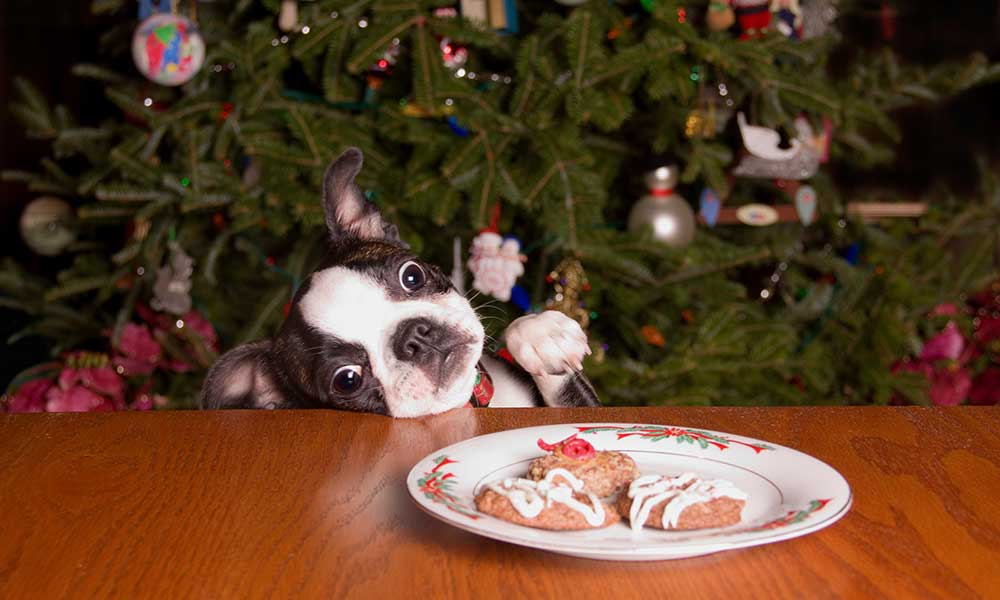If the idea of putting the Christmas tree up fills you with dread, and you find yourself worrying how your dog will embarrass you this year in front of your guests, this one's for you. Some training tips for the most common of Christmas problems; stealing, jumping up, and overexcitement.
Book A Training Class With Us


Management
I know we bang on about this one, but it really is so important. If you limit your dog being able to practice the behaviour it makes it far easier for you to train them not to do it. It also means you can choose when to train, rather than having to react in the moment because they are doing something they shouldn’t be.
Management can include but isn’t limited to; crates, baby gates, puppy pens, pushing food to the back of the worktops, a pen around the tree.
Before doing any of the following exercises, think about any environmental changes you can make to set your dog up for success.
Stealing
This one is for the dogs that steal objects… baubles, presents, socks – it all applies!
The first bit of advice is to pick your battles carefully. You do not need to chase your dog and wrestle things out of their mouth every time they steal something. This will result in a dog that either whizzes off as fast as they can with their treasure, or a dog that starts grumbling and growling when they see you coming. Neither of those are ideal.
If it isn’t life threatening or dangerous, this is what you will do…
Pretend you haven’t seen them. Grab a treat or a toy. Bowl the treat or the toy away from your dog. When your dog lets go of their treasure, you can pick it up and do one or two more bowls of a treat or a toy – this stops the dog realizing that treat = lost treasure.
One of the biggest things that causes a dog to not let go of something is the confrontation of the situation; we loom over them, hands reaching into their mouth, usually saying ‘leave it! Will you leave it!’ and it can be frightening! Paired with the fact that these hands then take away something the dog perceives as special, it’s a recipe for disaster. Whenever we take something from our dogs, we should give something in return so that it becomes a positive experience.
Jumping on Guests
Jumping up can be super rewarding for dogs. Even when we think we are deterring them by saying ‘no’ or pushing them off, dogs often still find the attention rewarding. Therefore, ignoring is best. However, we will have far more success if we combine ignoring the behaviour with telling the dog what we would like them to be doing before they jump. Something as simple as a ‘sit’ is an easy way to tell them what we would like – it sets them up for success and saves some frustration that may occur if we were to ignore the jumping. With consistency it will soon become muscle memory, and your dog will begin to sit to ask for attention.
The important thing with a greeting behaviour is that everyone is on the same page; the whole family, visitors, the postman, and the man down the road who always has to say hello. A simple ‘don’t say hello until she sits, please!’ is a great way to be concise and set a boundary.
Let us also think about setting the dog up for success – if the moment visitors come into the house is a major trigger for jumping up, you can always avoid it! Pop your dog behind a baby gate or in a different room and let your guests in. Once their shoes are off and they are seated (and briefed on how to greet your dog appropriately!), your dog can come out for a calmer, more controlled greeting.
Overexcitement
As with any undesirable behaviour, we will have far more success if we think about what we would like our dog to be doing instead of what we don’t want. What does your ideal Christmas dog look like?
For overexcited dogs, your ideal may be them snoozing happily on a mat whilst people chat. So let’s think about teaching a settle on a mat before Christmas arrives so that they know the behaviour well before the environment becomes more distracting.
Guide your dog onto the blanket and feed down on the fabric of the bed. You can ask for a ‘sit’ and then stay quiet. Reward on the bed for them staying there, and then start rewarding for calm behaviours that you might see. These could be:
- Lying down.
- Lolling onto one hip.
- A yawn or a sigh.
- Resting their chin on the bed.
- Closing their eyes.
As you practice this and your dog regularly offers calm behaviours, start to draw out the distance between your rewards. You can also give them a kong or chew (something that requires licking – no exciting puzzle games) and only let them eat it on this mat. Imagine how pleased you will be when you look down at your dog to reward and find they have fallen asleep – true calmness!
Don’t forget that relaxing (or trying to) in an exciting environment is really hard work. If your dog struggles in this kind of scenario, don’t expect them to do it all day long. Give them regular breaks in a quiet space to let them decompress slightly.

